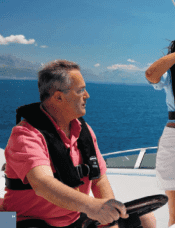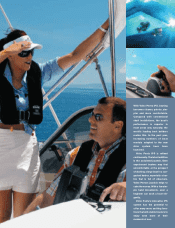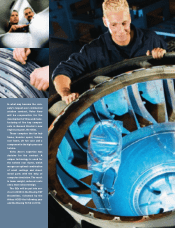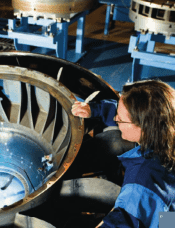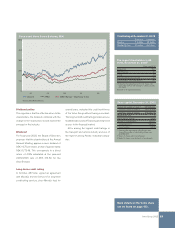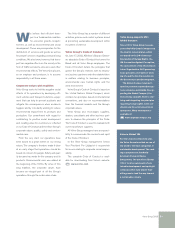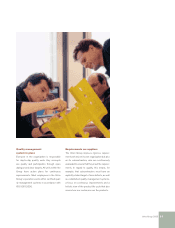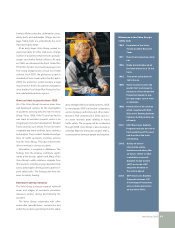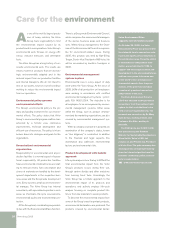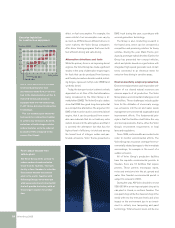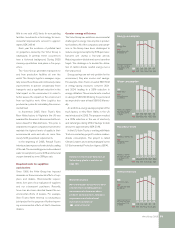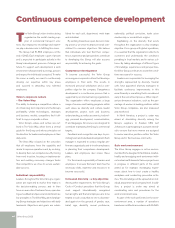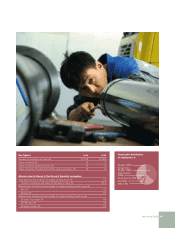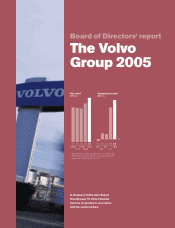Volvo 2005 Annual Report Download - page 38
Download and view the complete annual report
Please find page 38 of the 2005 Volvo annual report below. You can navigate through the pages in the report by either clicking on the pages listed below, or by using the keyword search tool below to find specific information within the annual report.
34 Volvo Group 2005
The increasing numbers of vehicles on
the roads, combined with increasingly
higher traffic speeds, increase safety
requirements on both drivers and vehicles. For
the Volvo Group, safety is about how our prod-
ucts are used in society. We work continuously
to minimize the risks and the consequences of
accidents and to improve safety and the work
environment for drivers.
Safety policy
Our safety program has two focal points: to
prevent accidents, to the greatest possible
extent, and to prevent injuries in the event of
accidents. Our safety policy stipulates:
• The Group’s products are characterized by
safety.
• The Group shall offer its customers products
that satisfy the highest safety requirements.
• The Group shall be regarded as the leading
manufacturer of safe vehicles and transport
products, equipment and systems.
For the Group’s business areas that mainly
supply components for installation in finished
products manufactured by other companies,
such as boats and aircraft, safety is synonym-
ous with quality and reliability.
The safety organization
The overall safety work is coordinated by the
Volvo Group’s Safety Committee, which
includes safety experts from Group com-
panies. The Safety Committee continuously
follows-up the action plans prepared by each
company against the background of the
challenging safety objectives established by
the Group Executive Committee. In 2005,
Senior Vice President Karl-Erling Trogen,
who was then a member of the Group Execu-
tive Committee, was Chairman of the Safety
Committee. He will be succeeded by Jan-Eric
Sundgren in 2006.
Continuous process
The Group has its own specialists, which ana-
lyze accidents involving vehicles from the
Volvo Group. The findings are used in product
development, safety testing and manufactur-
ing of new products. Furthermore, all of the
Volvo Group’s products are safety tested using
realistic methods.
The basis for good safety is reliable and
efficiently functioning products that respond
in the anticipated manner. The user must be
offered optimal conditions for handling the
product, even in complex situations.
The fact that a driver or operator can use
their vehicle or machine in the correct way is a
basic requirement for enhanced safety.
Acc ordingl y, dri ver information and tra ining are
important elements of the Group’s under-
taking, as is the training of mechanics who
ensure that the maintenance of vehicles and
engines is conducted and quality controlled.
We encourage our customers to provide their
employees with the right training and the
opportunity to follow the safety guidelines of
the Volvo Group and authorities. For example,
using the safety belts currently provided in
Volvo’s trucks, buses and construction equip-
ment. An important issue in the future is the
development of a system that contributes to
the increased use of safety belts.
Focal point 1 – Accident prevention
Human errors or misjudgments are major con-
tributing causes in most traffic accidents,
which reflects the importance of preventive
safety characteristics such as good visibility,
driving qualities and brakes. Furthermore, the
human factor is most often the cause of acci-
dents with construction machines.
The driver’s workplace is an area of focus.
Using various methods, the Volvo Group is cre-
ating the conditions for enhanced interaction
between the user, vehicle and the surrounding
environment. The company has made consid-
erable progress in developing systems that
help the driver or operator to handle the vehicle
as safely as possible.
For example, trucks and buses can be
equipped with electronically controlled disc
brakes that can be used in combination with a
stabilization system – Electronic Stability Pro-
gram (ESP). Another example is the Adaptive
Cruise Control (ACC), a radar based system
Alco-locks
In December 2005, Volvo Trucks
participated in a seminar on alco-
locks in Brussels arranged by
Swedish authorities. The aim of the
meeting was to demonstrate how
the equipment works and to per-
suade the EU to introduce the alco-
lock as standard on all commercial
vehicles.
For the past couple of years the
alco-lock has been available as an
option on Volvo trucks in Scandi-
navia. In 2005, sales of the system
rose sharply. Today, more than
5,000 buses and trucks in Sweden
are equipped with the system and
the Volvo Group is convinced that it
contributes to saving lives.
The alco-lock is easy to use and
features a starter inhibitor and a log
function. The lock consists of a cen-
tral unit and a hand-held unit with a
replaceable mouthpiece. In order to
start the engine, the driver must first
activate the alco-lock and then blow
into the mouthpiece. If the driver’s
breath contains traces of alcohol,
the central unit will cut the supply of
current in the electrical system, thus
preventing the engine from starting.
that automatically adjusts the vehicle speed
and distance in relation to the vehicle ahead.
The safety solutions of the future include
systems that warn the driver or operator if he
or she becomes tired or distracted. One ex-
ample is the Lane Departure Warning system.
It detects if the vehicle has an unintentional
change of direction – a sign that the driver has
fallen asleep or has lost concentration.
Focal point 2 – Injury prevention
The Volvo Group is a leader in designing ve-
hicles that protect the driver and passengers
in the event of a collision. Safety solutions
include overturn-tested cabs and bodies,
Constant focus on safety


